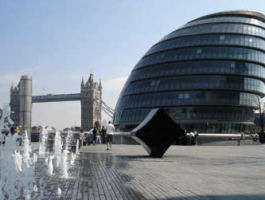Great Britain: Can the UK solar thermal market recover from its terminal decline?
November 4, 2013
For almost a year now, the UK government has been recording statistics on all the subsidised renewable heating and electricity installations. It is now possible to compare the success of the subsidies for different technologies using the peak power rating. The chart shows the cumulative peak power for non-household projects within the Renewable Heat Incentive (RHI). Solar thermal has had a poor performance with only 1 MW installed capacity since 2010, which represents less than 1 % of all RHI-subsidised renewable heat installations. This is no surprise because the number of UK sales by square metre of collector area has been in decline since mid-2011.
So why has it gone so bad for solar thermal in the UK even though it has had support under the Renewable Heat Incentive of 0.09 Pound Stirling (GBP)/kWh? Many have blamed the delays in the introduction of the domestic Renewable Heat Incentive (RHI) which is still not available until spring 2014. If this blame is correct then this would mean there should be a similar development between the markets of household and non-household. But when we examine the trends of the domestic subsidies, it is not so bleak. Here we see that over 10 MW of solar thermal has been fitted under the temporary Renewable Heat Premium Payment (RHPP) scheme. Although household air source heat pumps is the winner, solar thermal look more successful than non-household representing over 20% of all subsidised household renewable installations (see chart below). So is there really hope for UK solar thermal?
Whilst it is true that the UK has been waiting a very long time for the detailed announcement on the household Renewable Heat Incentive, this hiatus can not be entirely to blame. This is because the alternative subsidies such as RHPP have had some effect. But simply doing well in household subsidies still has not prevented overall UK collector sales from declining. We must now consider what will happen in the complete changeover to household RHI in spring 2014.
Firstly, if any recipients of the RHPP want to transfer to RHI, then they have to pay the RHPP money back. So they have to believe they will get more money from RHI or they will not wish to change. Secondly, to claim RHI or a new RHPP, the householder must have an overall house survey done called the Green Deal Assessment (GDA) which ensures they consider any other energy measures and meet minimum energy efficiency requirements of loft and cavity insulation. For some properties, this will be required first before further funding occurs. But the key issue remains if there will be more money for each household under the RHI. During October 2013, the government released more details. So now we know the money will vary for each property and be calculated against the thermal energy arriving at the storage tank according to a ‘deeming’ calculation made by the installer at a rate of 0.192 GBP/kWh for 7 years. The new calculation is based on the previously known UK SAP 2012 model. It can be downloaded from this link (see also attached excel file).
The Solar Trade Association announced that it expects with this new calculation that some householders will get RHI payments total over 7 years of GBP 1,300 to 3,200. In general if the household is larger, up to six persons, this means the hot water use also becomes larger. This makes sense as there will be a larger tank and collector area hence the generated thermal energy is larger. So the short answer is for most people, the RHI will pay much more than the RHPP.
But the new calculation method, now called MCS024, has immediately come in for criticism from the industry, because it is biased and inaccurate. Speaking for Apricus Solar Europe, Dr. Patrick Davis confirmed that “As it stands the DECC/MCS deeming calculation method discriminates against certain advanced technology types in favour of less advanced technologies. It is not accurate and not reliable.” What Davis refers to is the problem that not all the collector test results of ISO 9806 will be used in MCS024. This leads to a key omission of the Incidence Angle Modifier. So now the characteristics of CPC collectors are no longer well represented. Also there is no response in the calculation results to changes of hot water demand between each day and hour. This is because MCS024 is now only based on the number of occupants and not the type of occupant. So for example the careful householder is not properly rewarded, if they leave a cold tank ready to be heated by the sun each morning.
Another problem is that MCS024 climate data is restricted to use only around twenty regions for the whole of the UK. Some of these regions include large coastal and mountainous areas, yet only one radiation value can be used despite this wide range of terrains. The result is that some households in the sunny areas get the same RHI payments as those in the cloudy areas. So here MCS024 now creates false winners and losers due to a ‘postcode lottery’. It would have been much better that MCS024 used commonly available homogeneous climate databases that use a much more detailed resolution.
It is also not clear how the new ‘deeming’ method will evolve for the more complex markets of solar assisted space-heating, swimming pools, air heating and process heat loads which have become growth solar thermal markets in other countries. The industry already has commercial simulation software which works well for these situations.
There is no doubt that the new MCS024 calculation generally provides better results than the industry were first expecting. Furthermore, with the energy utilities just increasing their charges for gas and electricity by nearly 10%, the subsidised cost of solar heat is starting to make more sense.
More information:
DECC: http://www.gov.uk/government/organisations/department-of-energy-climate-change
http://www.apricus.com


